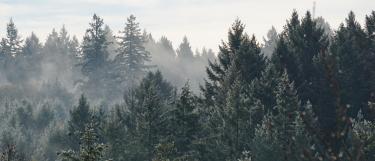
The Forest – between Idyll and Disaster
The forest as the scene, backdrop or even protagonist was the focus of a film and lecture series mounted in the 2022/2023 winter semester by the Institute for European Art History of Heidelberg University in cooperation with the GLORIA art film cinema. The series entitled “The Forest – between Idyll and Disaster” combined the projecting of selected films with an introductory presentation.
From different angles, the speakers took up the question of what role the “myth of the forest” has played in different periods in the history of film. They showed how the forest has again and again been the subject of new cinematic interpretations and also talked about issues from the contexts of youth literature, theology and film practice. The series, organised by Prof. Dr Henry Keazor and Dr Alexandra Vinzenz from the Institute for European Art History, was pitched at an academic audience but also meant for the wider public.
In the first lecture, film and literary critic Georg Seeßlen explored the myth of the German forest on the example of Hans Deppes’ “Schwarzwaldmädel” (1950), and its role in creating a supposedly new homeland (Heimat) feeling in post-war Germany. Johannes Litschel, co-manager of the federal association of communal film work commented on Céline Sciamma’s film “Petite Maman” (2021). The forest in children’s and youth literature was the topic of Melanie Trolley from the Academic Portal for Children’s and Youth Media. The starting point was Tage Danielsson’s filming of “Ronja Räubertochter” from 1984. Under the heading “From the Garden of Eden to Harmageddon”, Prof. Dr Joachim Valentin from the Goethe Universität Frankfurt discussed the film “Antichrist” (2009) by Lars von Trier, in which the forest is first a place of withdrawal and then mutates into a place of nightmarish disaster. The series concluded with a documentary looking at the extensive forest areas in Germany, which since the 1970s have been associated with urgent ecological questions. Jan Haft, the documentary filmmaker, took the viewers on a trip to the wilderness with his film “Das grüne Wunder – Unser Wald” (2012).
Picture gallery
Show full screen mode

Show full screen mode

Show full screen mode

Show full screen mode

Show full screen mode

Show full screen mode

